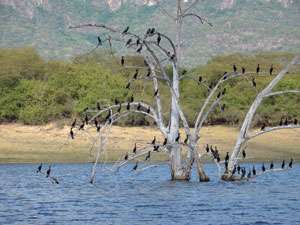
LANSING, Mich. — Twelve years ago, the Federal government finally reacted to concerns from anglers and fish farmers and implemented control measures for the double-crested cormorant. Have tactics such as oiling eggs and shooting worked for managing this fish-eating bird?
Yes. And no.
A Lake Huron perch fishery that crashed more than 10 years ago has rebounded since cormorant numbers were reduced by 90 percent, according to Dave Fielder of the Michigan Department of Natural Resources.
But on Middle Island in Lake Erie, 20,000 roosting cormorants have reduced the tree canopy by 40 percent, “endangering some of the Great Lakes region’s rarest vegetation,” according to the Detroit Free Press newspaper. That’s because their acidic excrement burns plants and degrades soil.
In Texas, Tim Cook, conservation director for the Texas BASS Federation Nation, said, “I see cormorants on practically every fishing trip. And I have a friend who owns a hatchery. He says that his ponds are decimated by cormorants. They’ve really impacted his ability to raise fish.”
Seeing the birds on Lake Fork or Choke Canyon, however, does not necessarily mean that they are gobbling up all of the bass there.
“We believe there can be localized impacts on reservoir fisheries,” said Dave Terre, chief of Texas Parks and Wildlife’s Inland Fisheries Management and Research.
“However, because of the seasonal nature of their time in Texas and the fact they do prey primarily on rough and forage fish, the impacts on sportfish are usually not severe, and they are hard to quantify.”
From the Great Lakes to the Gulf and from Texas to the East Coast, the migratory birds remain the most troublesome, with 24 states now allowed by the U.S. Fish and Wildlife Service (FWS) to control the birds “for the protection of public resources.”
On Green, West Sister and Turning Point islands in Lake Erie, that public resource is vegetation and habitat for herons and egrets. To protect both, the Ohio Division of Wildlife and the FWS shoot the cormorants as they nest in the trees.
“We want to get ahead of the situation before the birds destroy all of the trees and start nesting on the ground,” said biologist Dave Sherman.
Thus far, results are promising. West Sister is greener now, he added, while the birds on Green are more spread out now and less likely to kill vegetation.
To the south, cormorants take advantage of flooded timber, long dead, for roosting in large impoundments, and they don’t seem to be doing damage to fish populations.
“On the big public reservoirs that have good prey populations, we haven’t experienced declines in fisheries, even though you see cormorants at nearly all of them,” Terre said. “Also, while you may see large roost areas on reservoirs, the cormorants often leave the reservoirs during the day to feed on smaller bodies of water and return in the evening to the roosts.”
On the Great Lakes, though, sportfisheries are more likely to be at risk, some managers there believe. They also suspect that the threat has been heightened by the introduction of zebra mussels, which filter algae from the water and greatly increase clarity.
Compared to fish, cormorants are much more effective predators, said John Casselman, a fisheries biologist for the Ontario Ministry of Natural Resources.
“A lake trout can’t fly 30 miles to find out where the prey fish are. And I have no doubt that the clearer water has made it possible for cormorants to see schools of prey fish from the air.”
Reduced water body size also translates into greater damage.
“At hatcheries, shallow ponds and small impoundments, cormorants can really hammer them [fish]. They can do damage in a short amount of time,” Terre said.
Air cannons, protecting netting and shooting reduce the threat, but their effectiveness diminishes over time. “After a while, the birds catch on,” he continued. “This is just something that we have to live with. Cormorants eat fish.”
Urban fisheries programs are especially at risk because just released trout and catfish make easy meals. “We’ve had problems with cormorants since we started the Neighborhood Fishing program at 14 lakes,” Terre said. “But this year was one of the worst, and because these lakes are in urban settings, there’s little we can do in the way of control.”
He’s hoping to enlist the aid of a local falconer to scare off the birds.
Are traditional tactics, including shooting and concussion cannons, having any real effect at all against the birds that anglers love to hate? Critics say local populations might be brought under control, but really all that is happening is that the birds are being chased elsewhere, to become someone else’s problem.
“There’s no magic bullet,” said Terre. “We’re definitely in a battle with these birds. But the good news is that we have more tools and latitude in dealing with them than we had in the past.”

